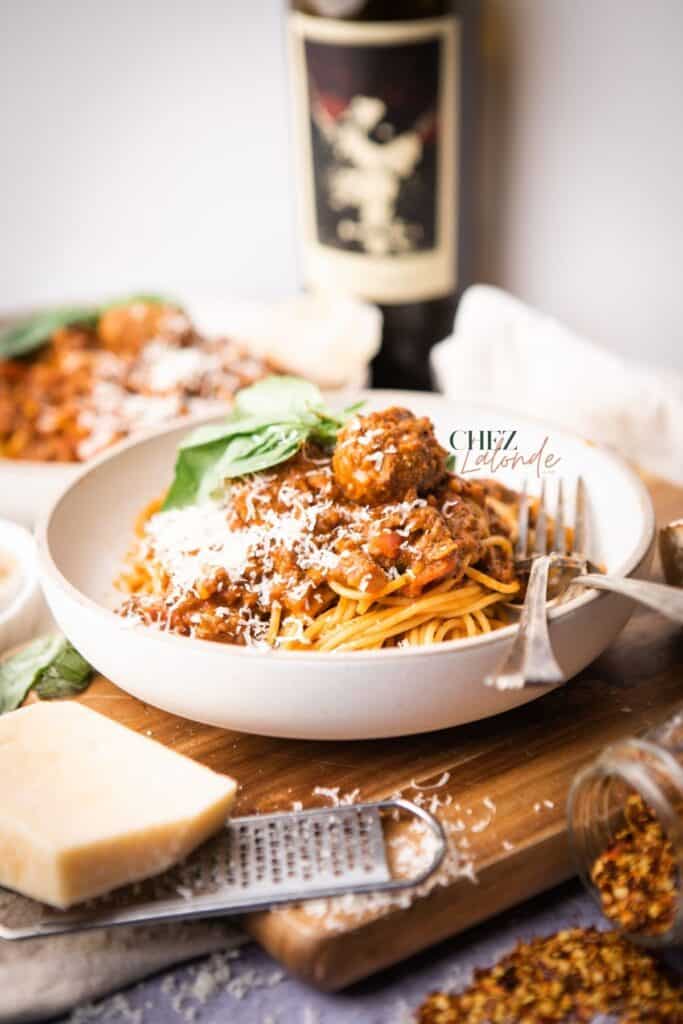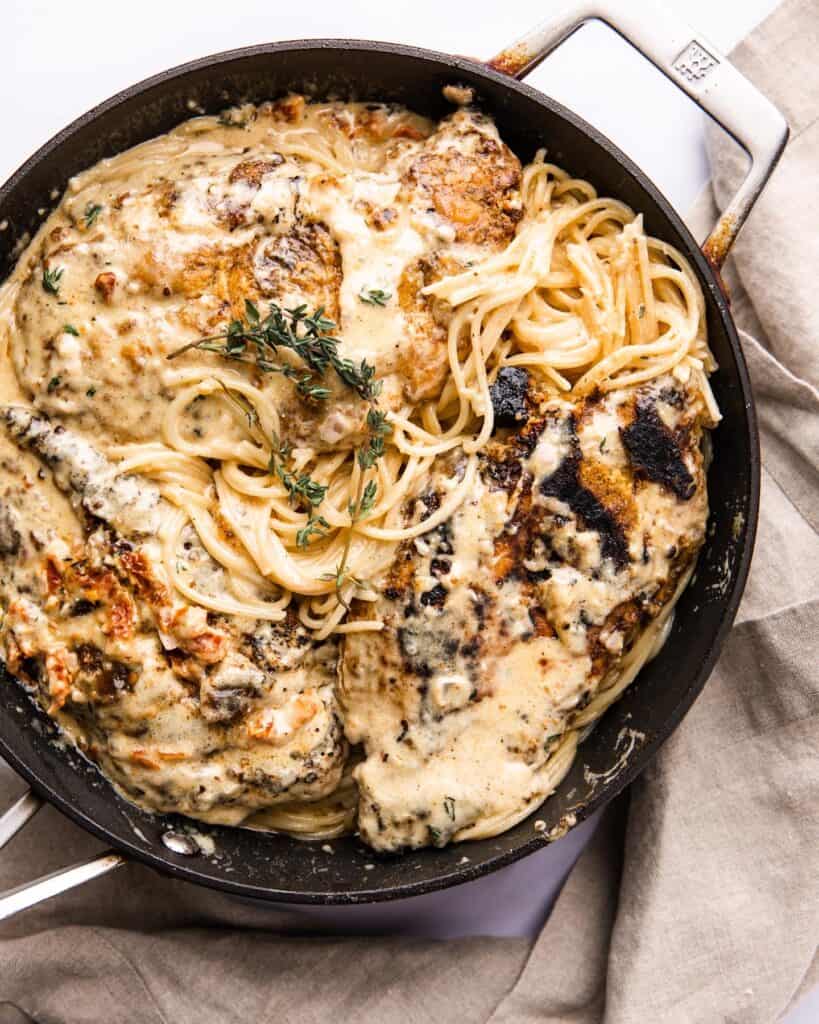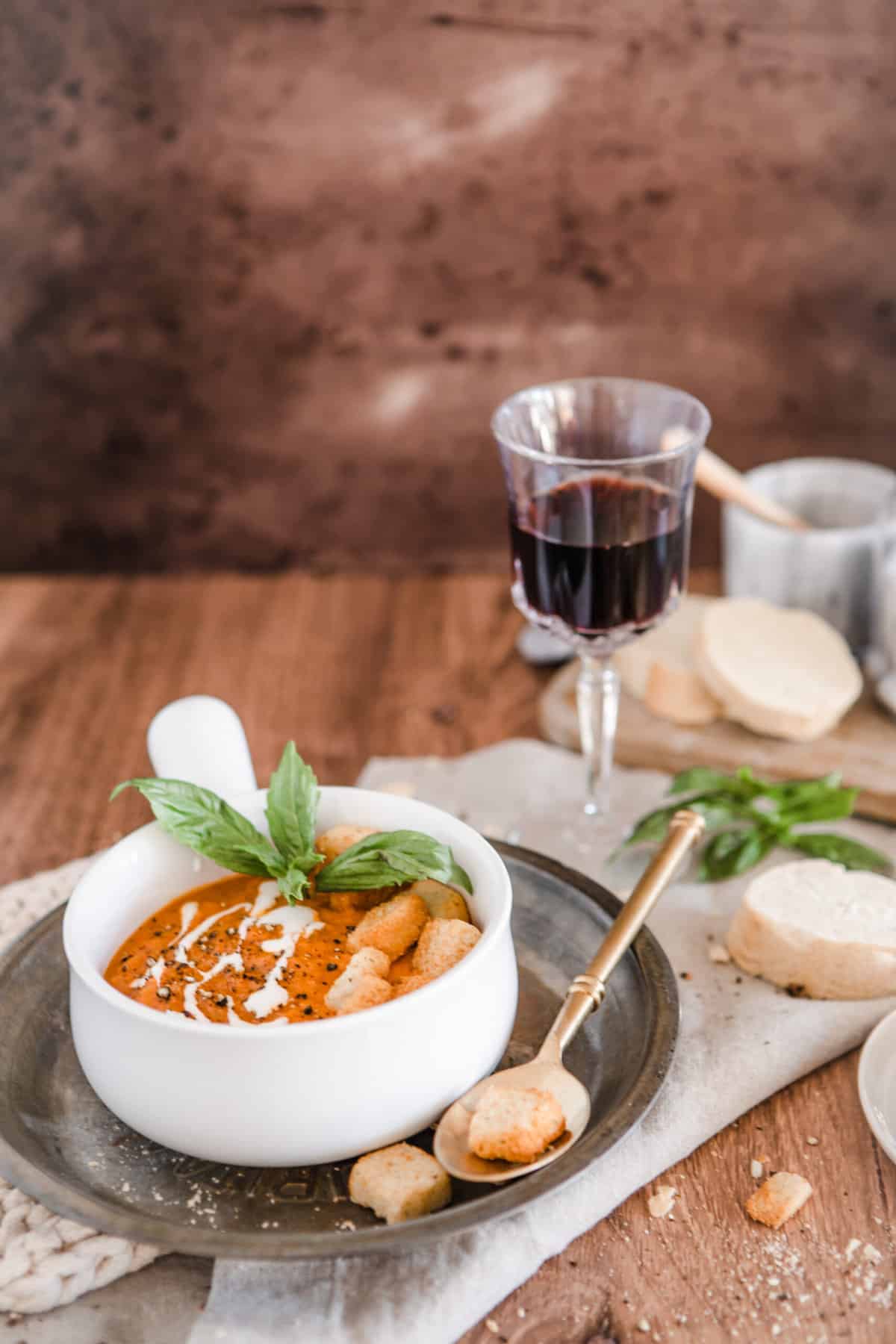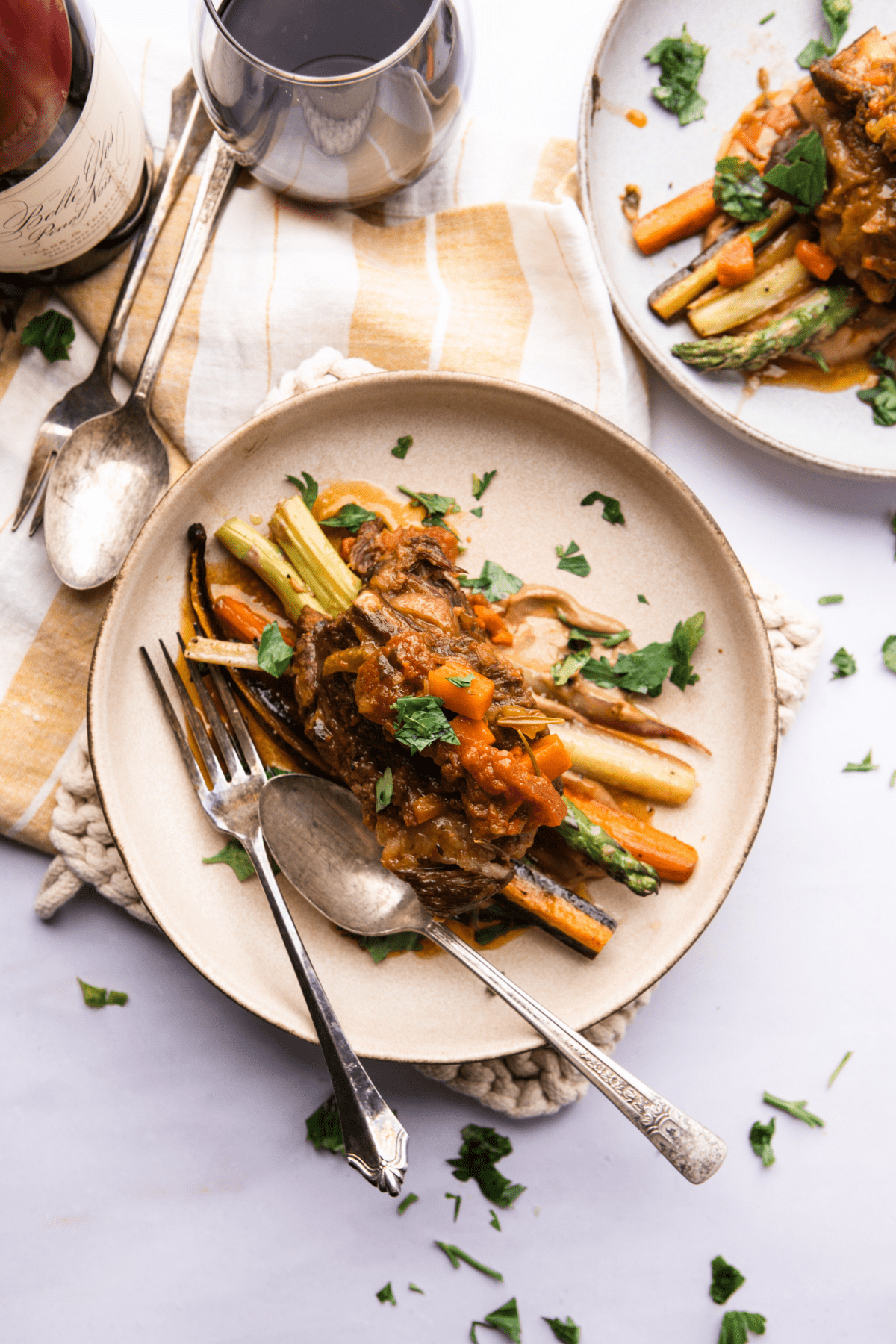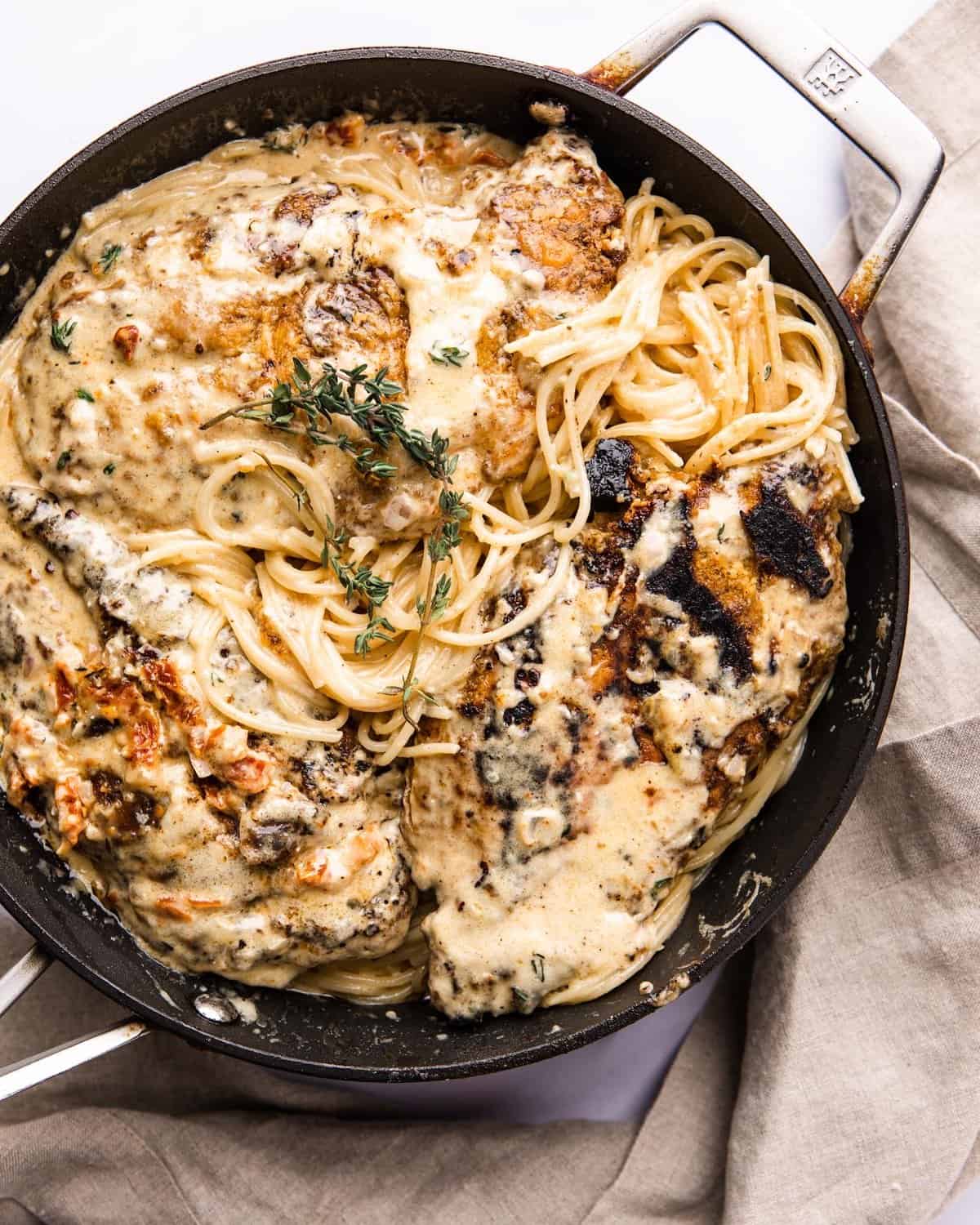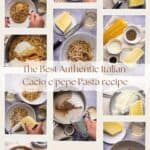The Best Authentic Italian Cacio e pepe Pasta Recipe
Italy is renowned for its various pasta dishes, each region with unique flavors and aromas. This authentic Italian Cacio e pepe pasta recipe is a must-try for any pasta lover. This popular Roman pasta is made with just a few simple ingredients; it’s a classic dish that is easy to prepare but packs a flavorful punch. Impress your guests with this traditional Italian dish and savor the flavors of Italy in every bite.

Disclaimer Notice: This website contains affiliate links. If you make a purchase through these links, I may earn a commission at no extra cost to you. I only endorse products or services I believe will be valuable to my readers. I appreciate your support.
This pasta dish is great for a quick weeknight dinner or a dinner party with friends. In this post, learn how to make an iconic Roman dish, including the proper technique for blending grated pecorino Romano and black pepper with the right amount of starchy pasta water to create a creamy sauce. You’ll also discover my secret to avoiding clumpy cheese sauce and achieving perfect consistency. Let’s start and bring a classic Italian “Cucina” to your home kitchen.
Recipe Snapshot
EASE: Easier to make than you might think
PROS: It’s easy and simple to make.
CONS: I honestly couldn’t think of any.
WOULD I MAKE THIS AGAIN? Another perfect pasta for date night.
What is Cacio e pepe pasta?
Cacio e pepe direct translation is
“Cacio” = Cheese
“e” = And
“Pepe” = Pepper
Cheese and Pepper Pasta in English
It is pronounced “KAH-cho eh PEH-peh.

Cacio is a Roman slag for Pecorino Romano cheese, a delicate cheese made with sheep’s milk. This pasta is simple to make and only consists of 3 main ingredients: Pecorino romano cheese, ground black pepper, spaghetti, bucatini, or tonnarelli pasta. This pasta dish also doesn’t contain heavy cream or butter (Just like how we make Carbonara). The signature creaminess comes from the super starchy pasta water and finely grated pecorino romano cheese. Adding black pepper gives the dish a subtle yet distinctive, spicy kick. This is a simple, easy-to-make, and beloved classic pasta dish worldwide.
What are the history and origins of this Roman pasta?

Cacio e pepe is a traditional and staple pasta from the Central Italian region of Lazio. The exact origins of cacio e pepe are unknown, but some said it is a staple dish among shepherds in the regions because it is easy to prepare with minimal ingredients and could be made on the go while tending to the sheep. The creamy and starchy cheese sauce with pasta makes a fulfilling and satisfying meal for the working class. Fast forward to today, cacio e pepe can be found on menus at Italian restaurants worldwide and continues to be enjoyed as a classic favorite that pays tribute to Italy’s culinary history.
What is the difference between Carbonara and Cacio e Pepe?

The main difference is their slightly different ingredients. You can visit my Carbonara post for detailed instructions and its recipe. To make the story short, they are both classic Roman Pasta. Carbonara consists of creamy egg, pecorino romano cheese, black pepper, and Guanciale (Cured hog jowl). Cacio e pepe only has finely grated Pecorino Romano cheese, toasted black peppercorns, and using starchy pasta water to make the creamy cheese sauce. Cacio e pepe is a great choice for people who is afraid of consuming raw egg and is not a fan of fatty-cure meat for either health or religious reason.
Is It better to use toasted peppercorns instead of ground pepper for this recipe?
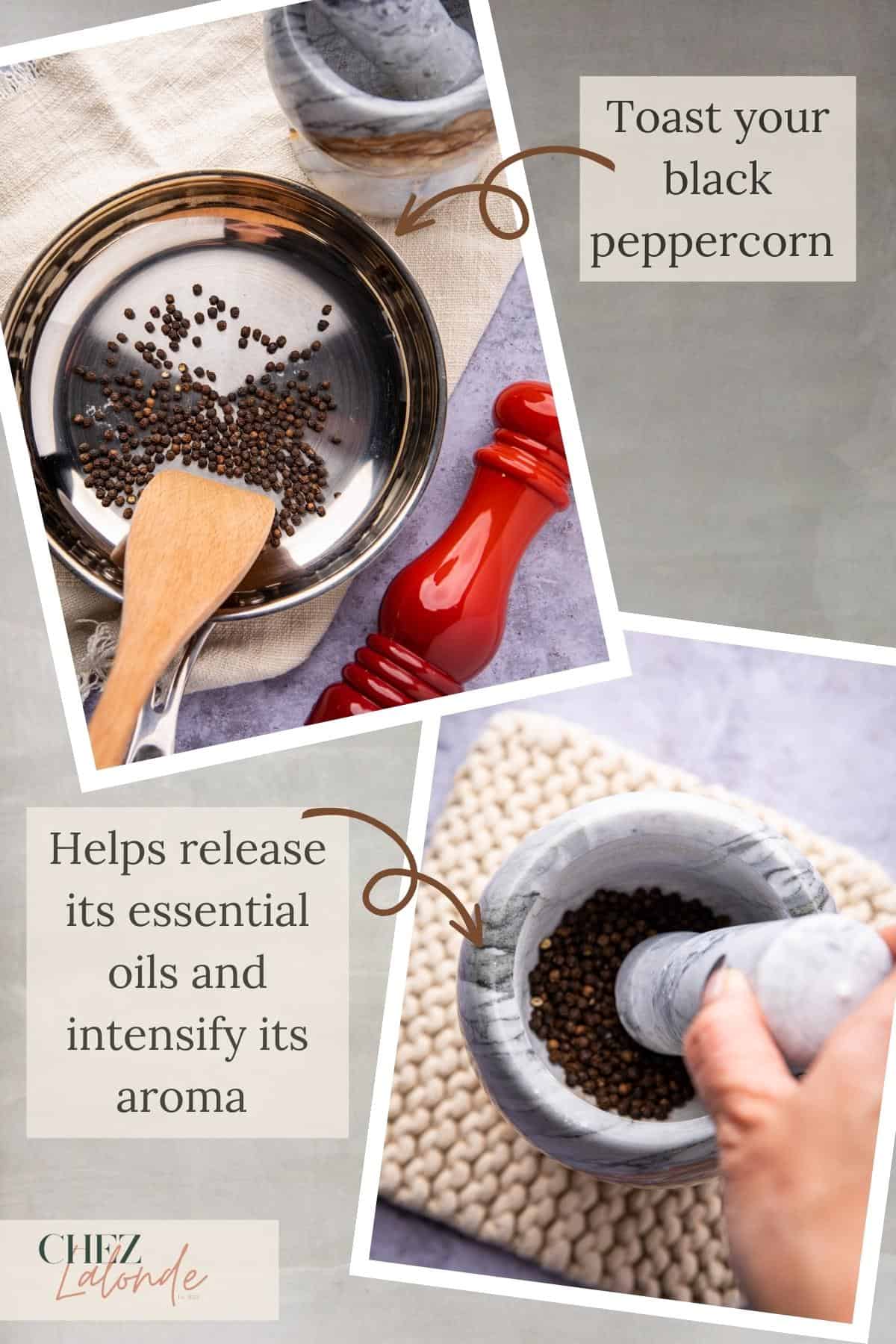
Yes, using toasted peppercorn instead of pre-ground black pepper will give Cacio e Pepe a more intense flavor and complexity. Using a mortar and pestle to ground the peppercorns will further increase the flavor by breaking down the pepper’s outer wall, releasing its essential oils, and intensifying its aroma. Using roasted peppercorn will enhance this dish’s flavor, so I highly recommend it.
Could I use a different kind of cheese in Cacio e Pepe instead of Pecorino Romano, such as Parmesan, Mozzarella, or Ricotta?
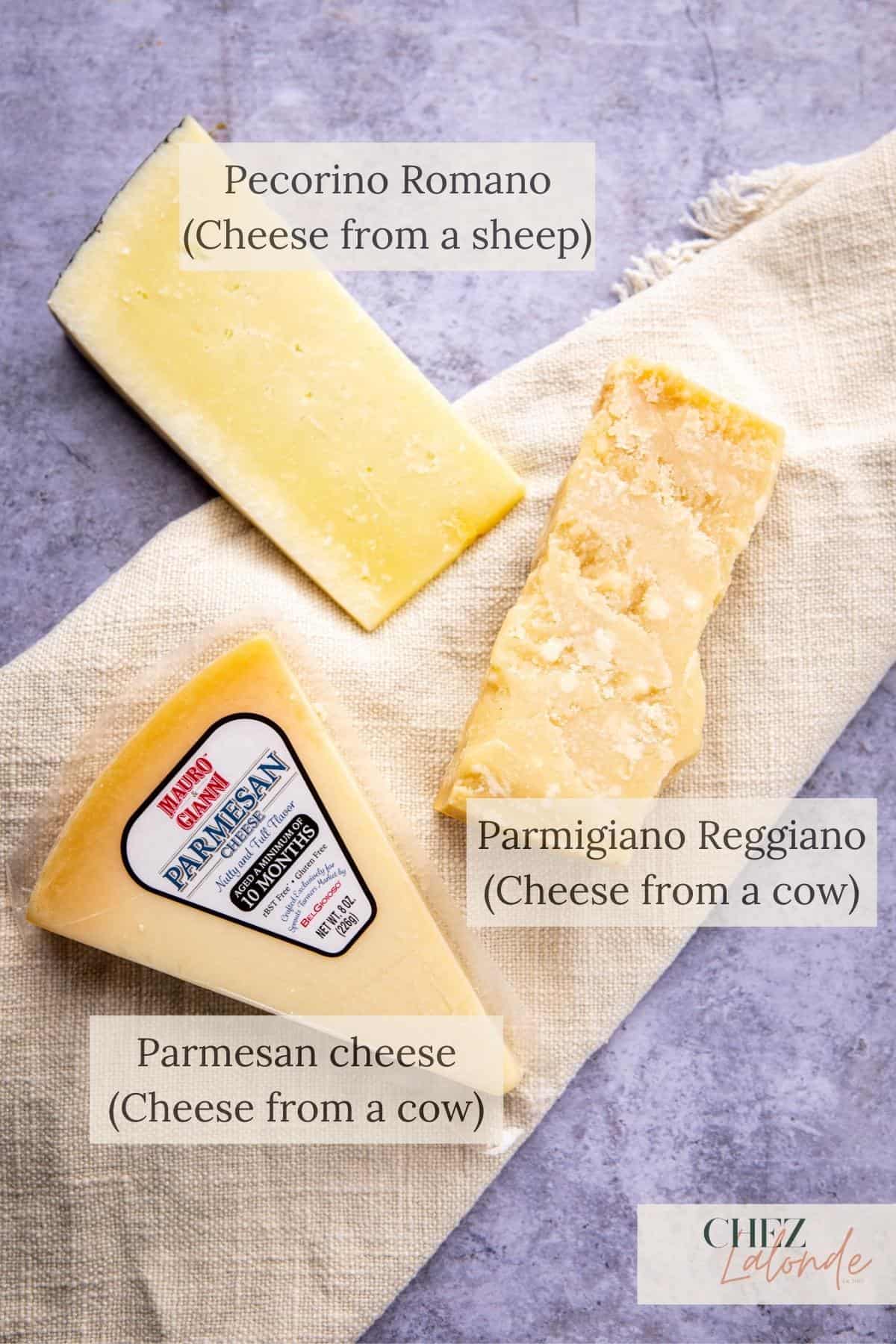
I am strongly against using other types of cheese other than Pecorino Romano. Pecorino Romano is a unique cheese made with Sheep’s milk. It has a sharp, tangy taste, with a salty flavor that adds an earthy, nutty flavor to your pasta dish, which other types of cheese can’t replicate. Parmesan, Mozzarella, or ricotta have completely different flavor profiles and textures that cannot use to substitute with this cheese. If you want an authentic experience, Pecorino Romano is the only way to go.

Ingredients Overview
For this recipe, you only need three simple ingredients: pasta of your choice, Pecorino Romano, black peppercorn, and sea salt. Don’t worry if you’re unfamiliar with all the ingredients; I’ll break it down for you and give you an explanation of each ingredient and its purpose in the recipe.
Let’s get started!
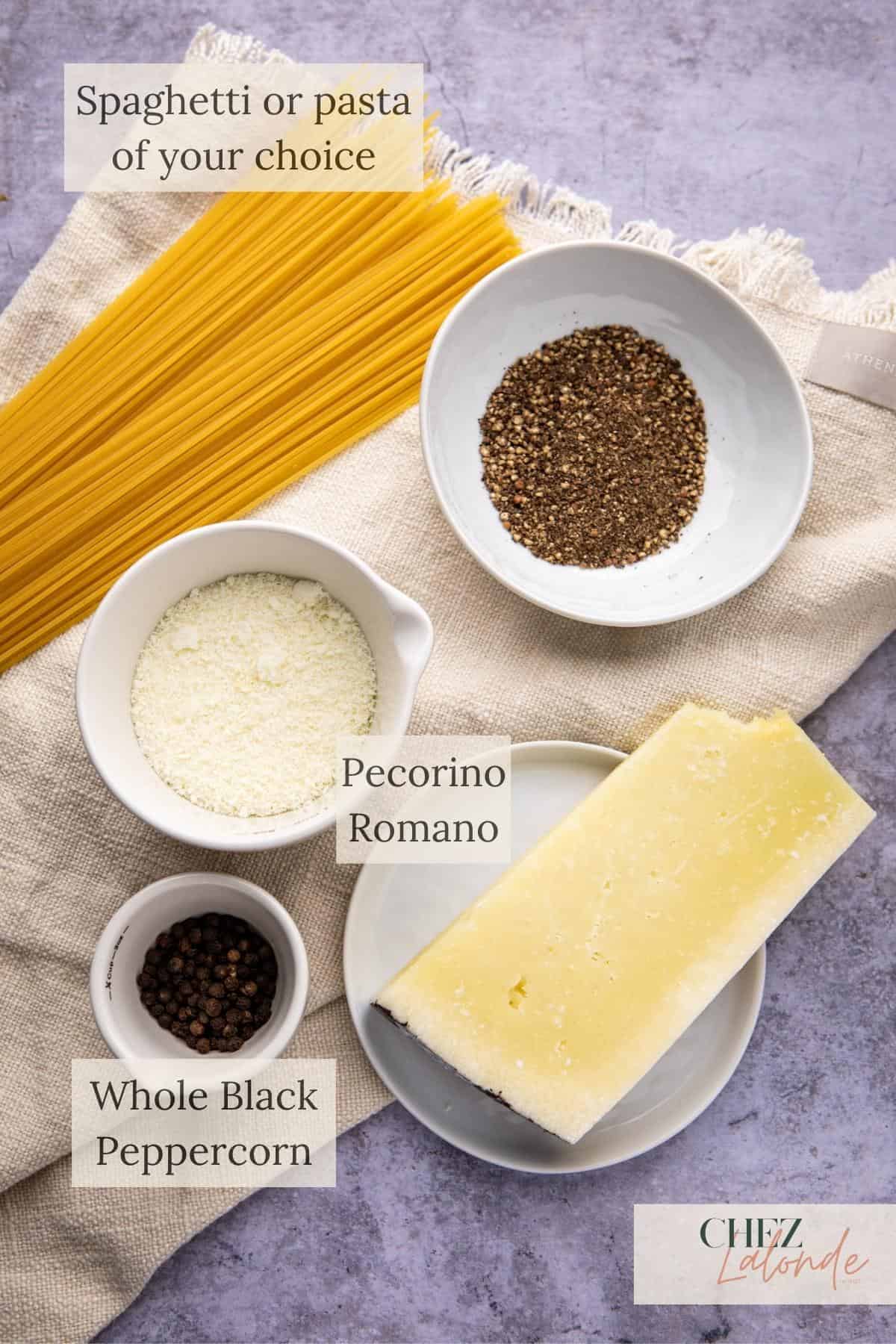
- Pasta of your choice – I highly recommend you use any rounded-shaped pasta; the traditional choice of pasta are usually spaghetti, bucatini, or tonnarelli with a great chewy texture.
- Whole black peppercorns – The secret to making this classic Italian pasta dish is to start with good-quality black peppercorns. Simply toast them in a frying pan on low heat for 30 to 45 seconds, then grind them in a mortar and pestle. This process helps bring out the aroma and adds an extra depth of flavor.
- Pecorino Romano – is a hard, salty Italian cheese made from sheep’s milk. Notable for its bold, savory flavor and sharp finish, it’s essential in classic Roman pasta dishes such as Carbonara, Cacio e Pepe, Gricia, and Amatriciana. It has a more intense saltiness compared to Parmigiano Reggiano.
Substitutions & Variations
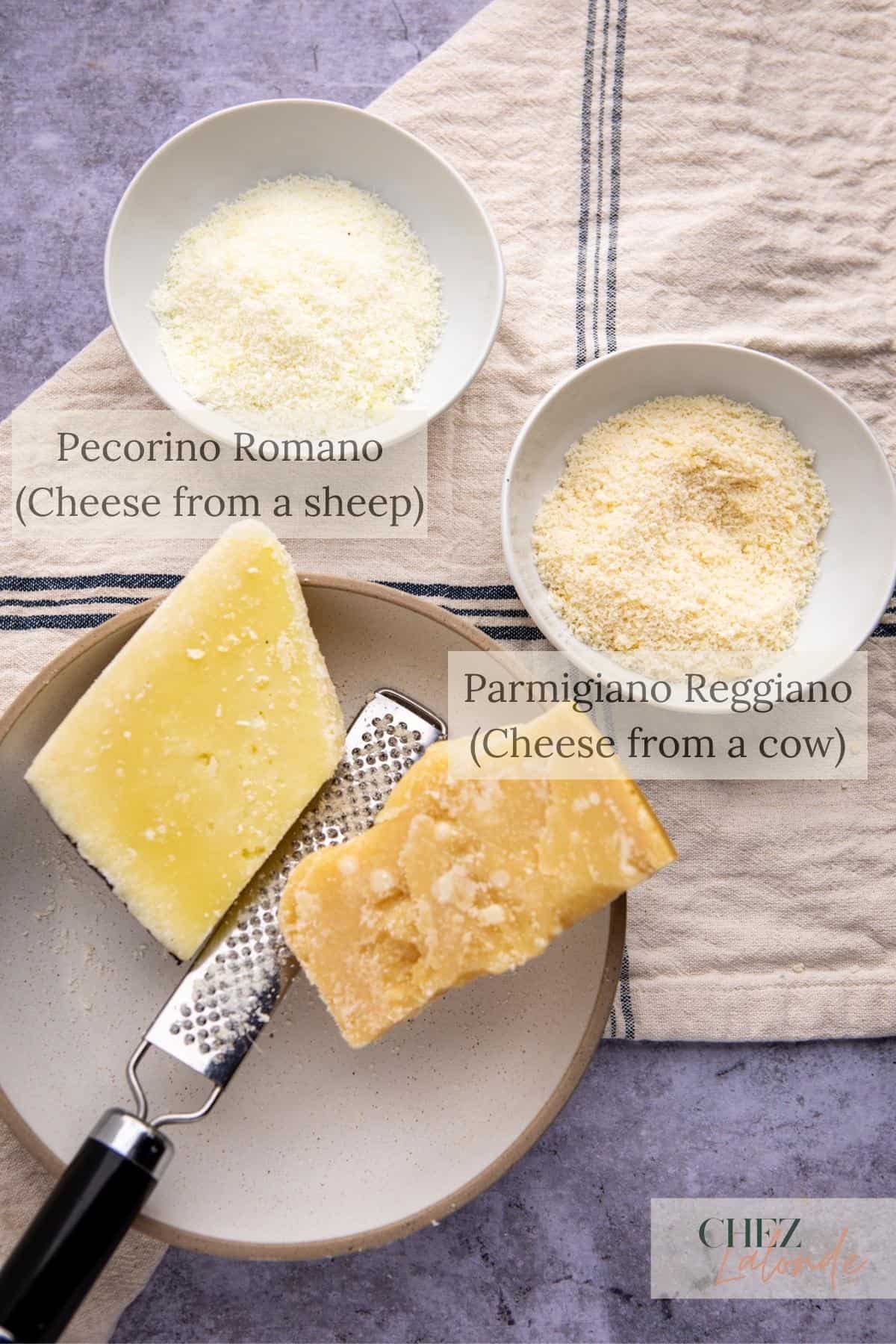
Suppose you want to keep the authentic Italian taste but don’t love the salty kick of Pecorino Romano. My perfect solution is to mix a bit of Parmigiano Reggiano to add sweetness to balance the saltiness. Depending on your desired flavor level, I recommend using 20 grams of Pecorino and 20 grams of Parmigiano Reggiano per person. Anything more than that, and you risk straying from a truly authentic dish.
The detailed step-by-step guide on preparing this pasta dish like a Roman
Toast the black peppercorns
Step 1 – Heat a small frying pan on low heat and add two tablespoons of whole black peppercorns. Toast the peppercorns for 30 to 45 seconds or until fragrant. You then crush the peppercorns in a mortar and pestle or put them in a ziplock bag, and use a meat tenderizer or rolling pin to crush them. Set your crushed pepper aside.
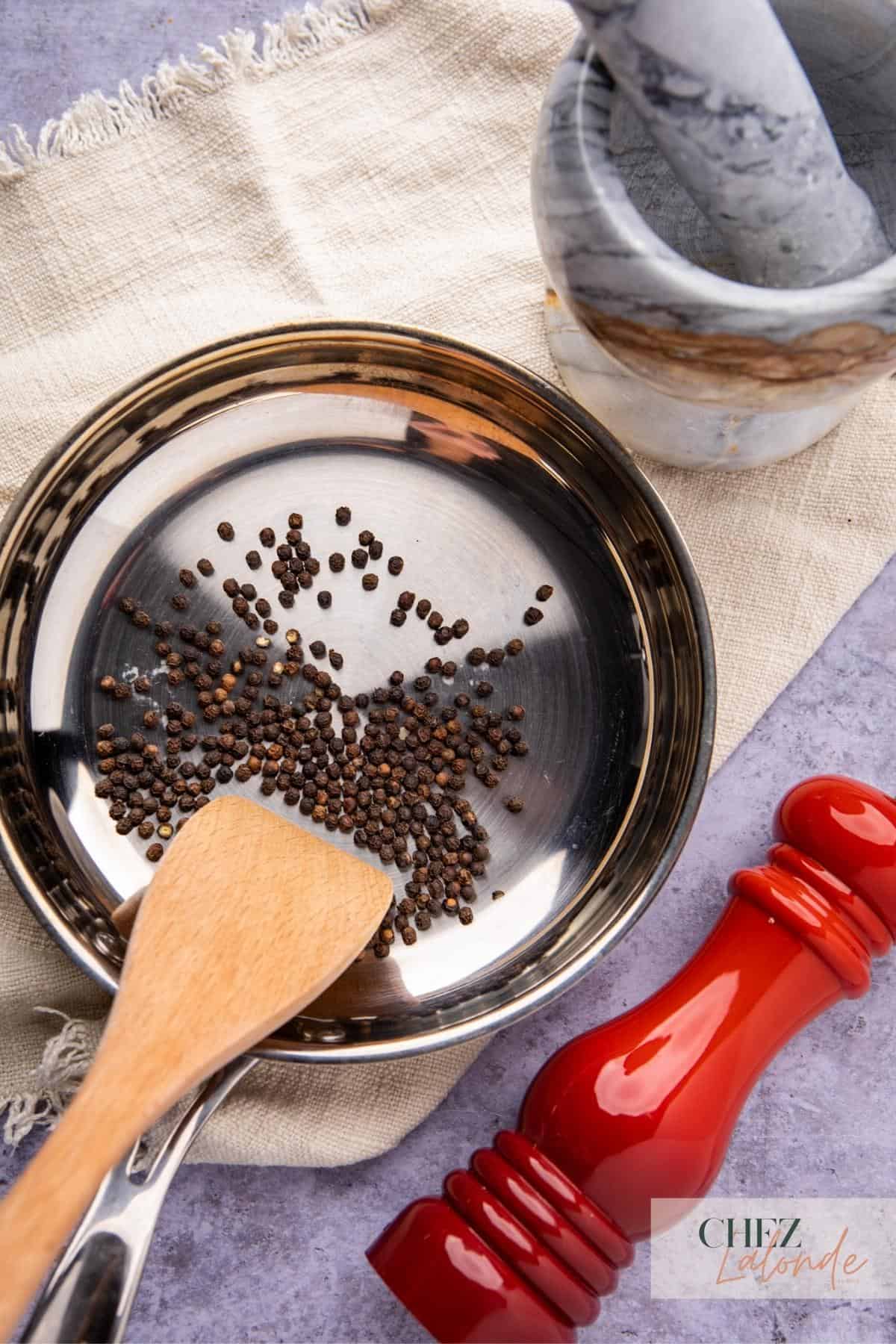


Cooking the pasta
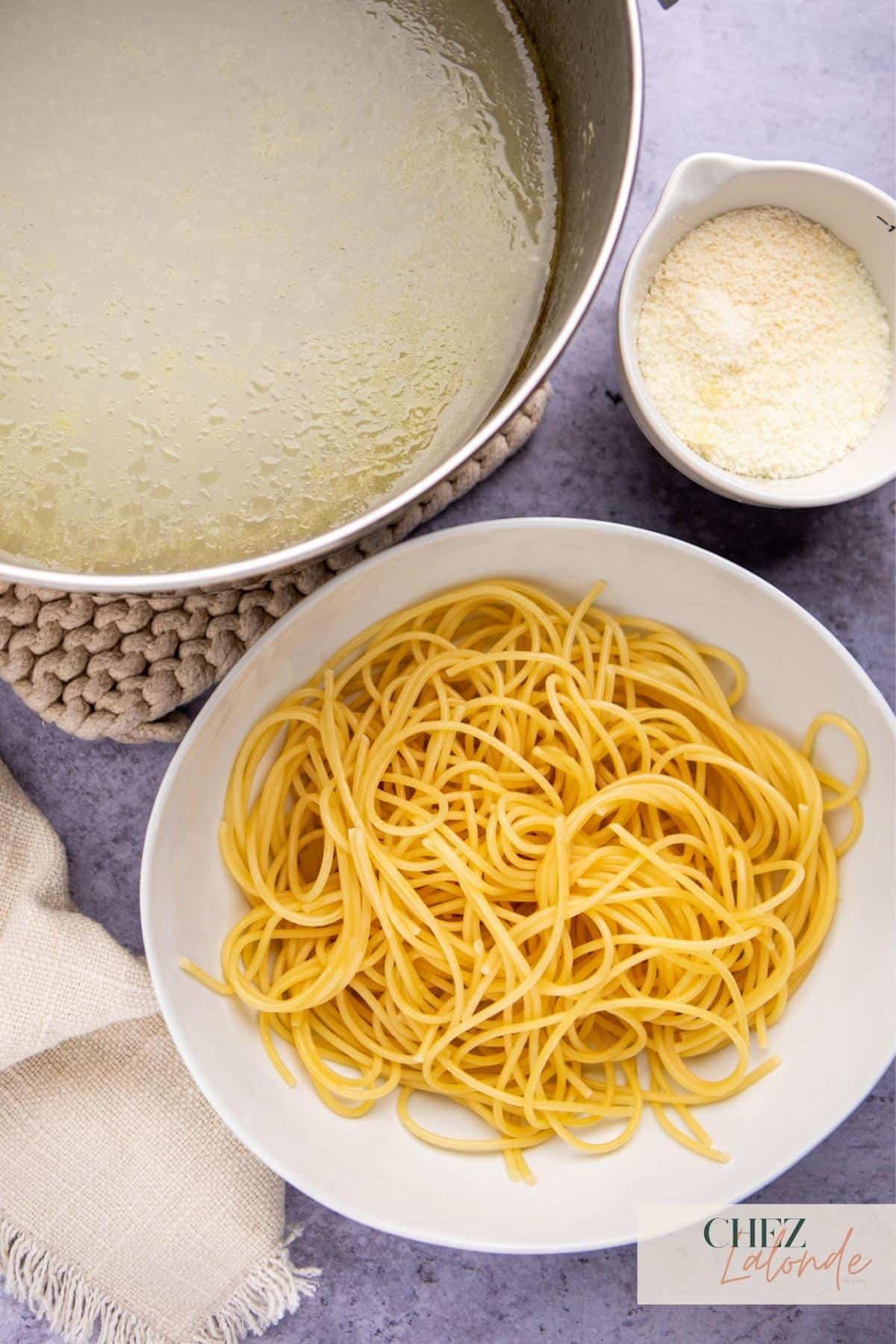
Step 2 – To get an irresistibly creamy and starchy cheese sauce, start here. First, fill a large pot with less water than usual. Add ¼ cup of sea salt to the water and bring it to a boil. Cook the pasta until it’s halfway done, following the package instructions – for example, if it says 10 minutes, cook for 5-6 minutes. Then finish cooking the pasta in the next step until it reaches al dente perfection.
Prepare the pepper water.
Step 3 – Heat a large frying pan over medium heat. Add the toasted crushed black pepper and one and a half cups of starchy pasta water. Bring the mixture to a boil, then add the pasta. Cook until the pasta is al dente.

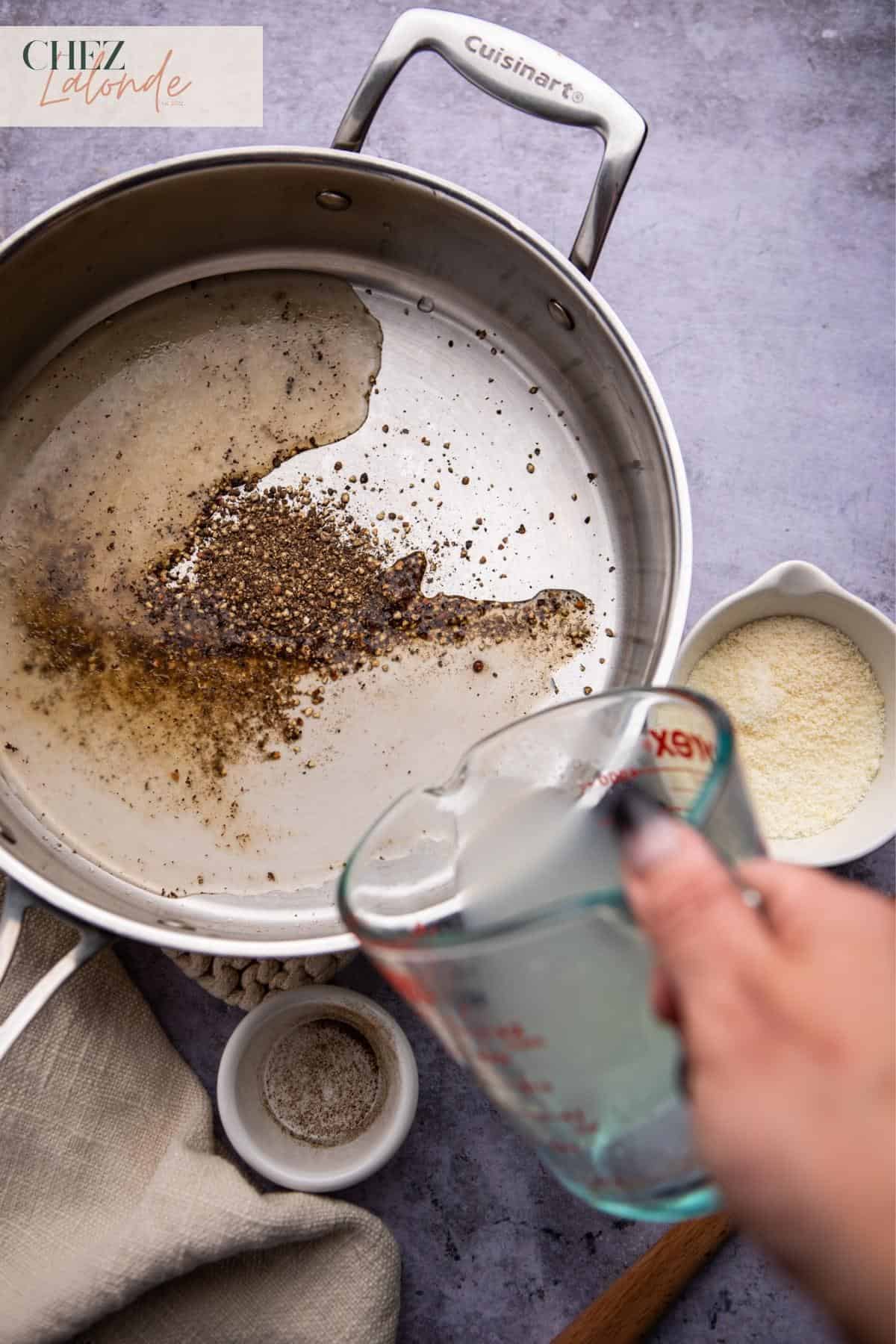
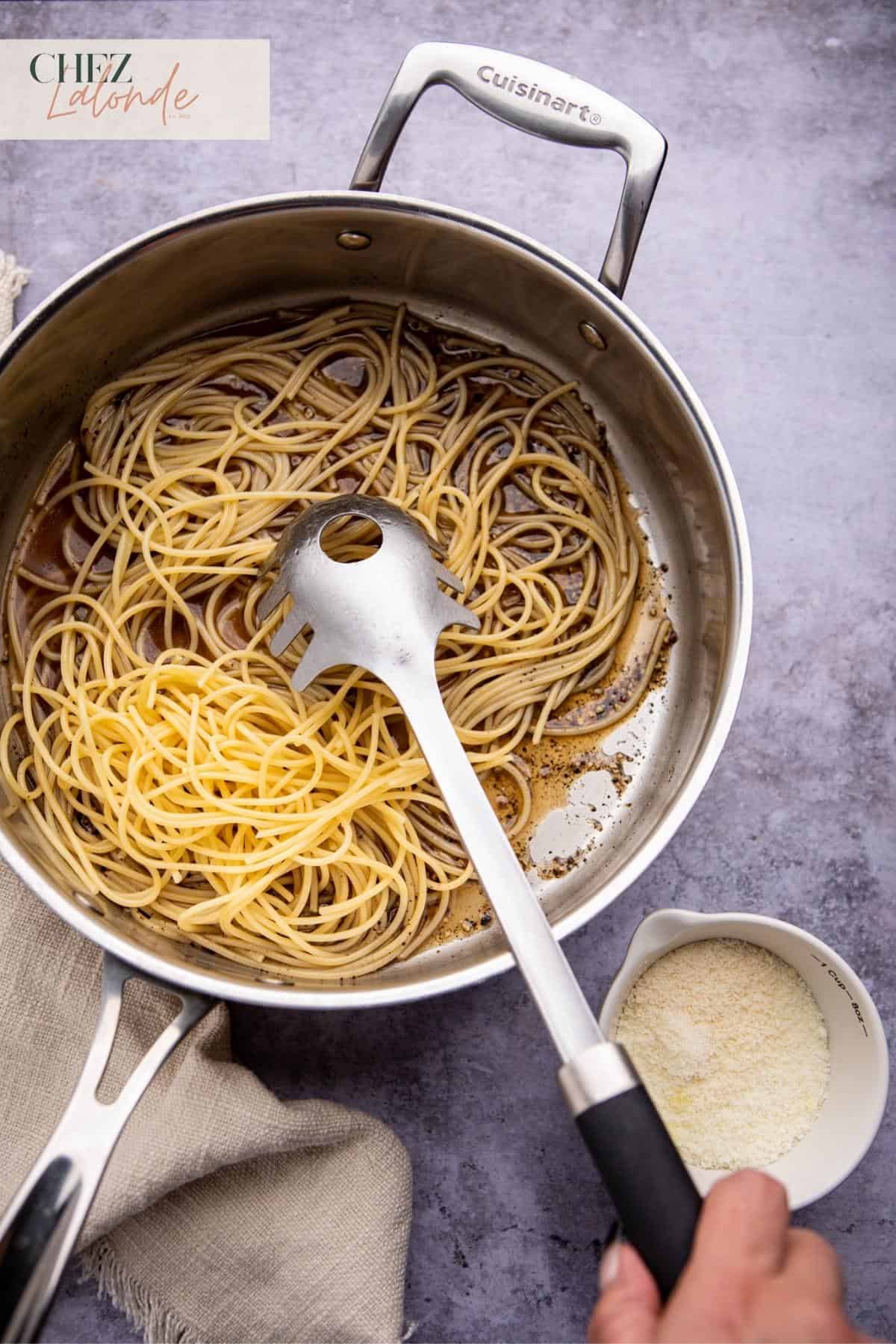
Prepare the creamy cheese sauce.
Step 4 – Take a clean bowl and use a Microplane to grate the pecorino romano cheese blocks finely. Measure approximately 40 grams of grated cheese per person using a cooking scale. Add starchy cooking water to the cheese and mix until it forms a paste-like consistency.
***NOTE: When combining the cheese and pasta water, maintain a 2:1 ratio of cheese to cooking water. For example, if you make the dish for two people, you will need 80 grams of grated cheese and 40 grams of starchy cooking water.***
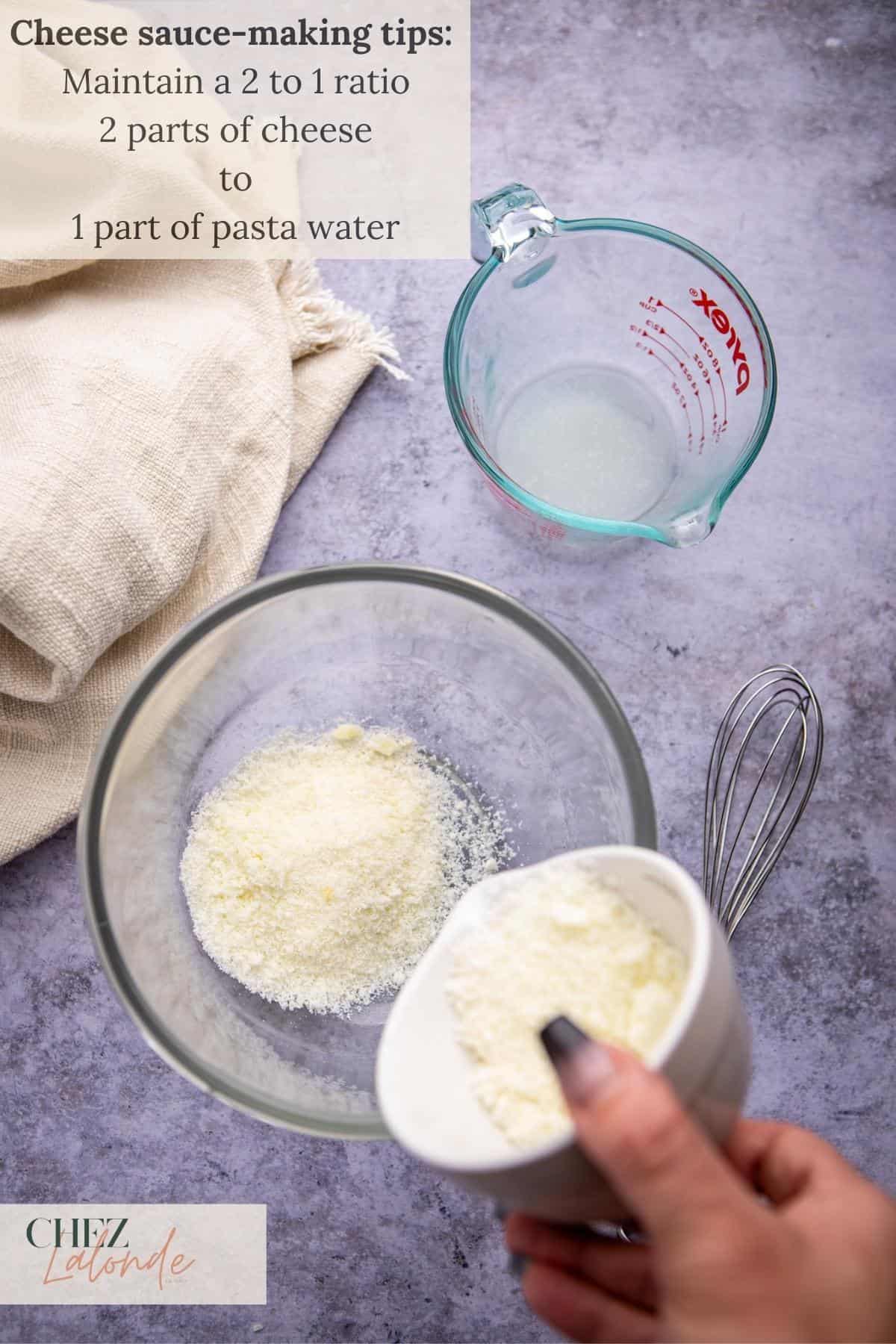

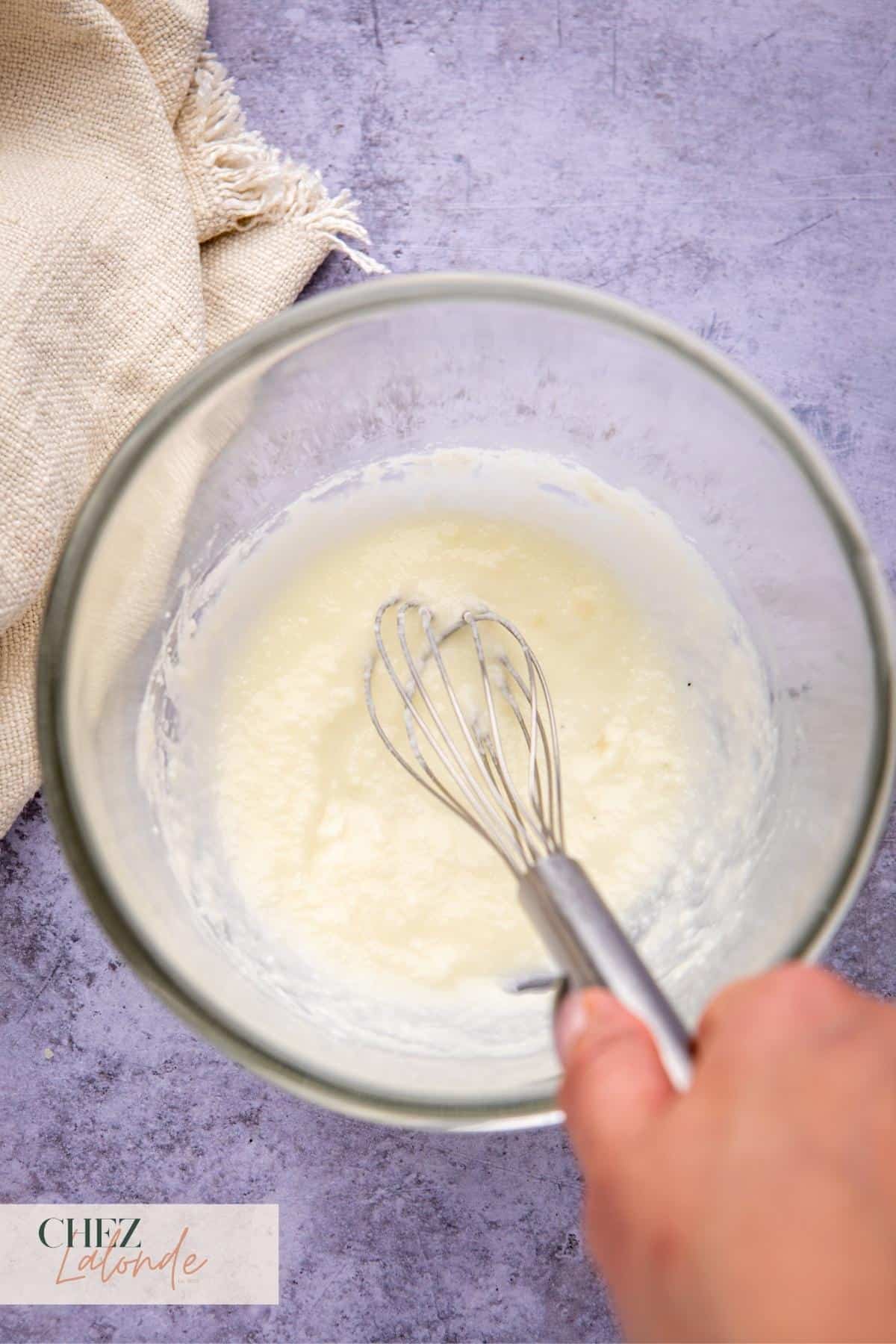
Assemble the dish
Step 5 – Remove the cooked pasta from the stove; slowly add the cheese mixture to the cooked pasta, one bit at a time. Mix the ingredients quickly and evenly so that all the pasta is completely coated. To avoid clumping and an off texture, avoid adding the cheese sauce to hot pasta all at once.
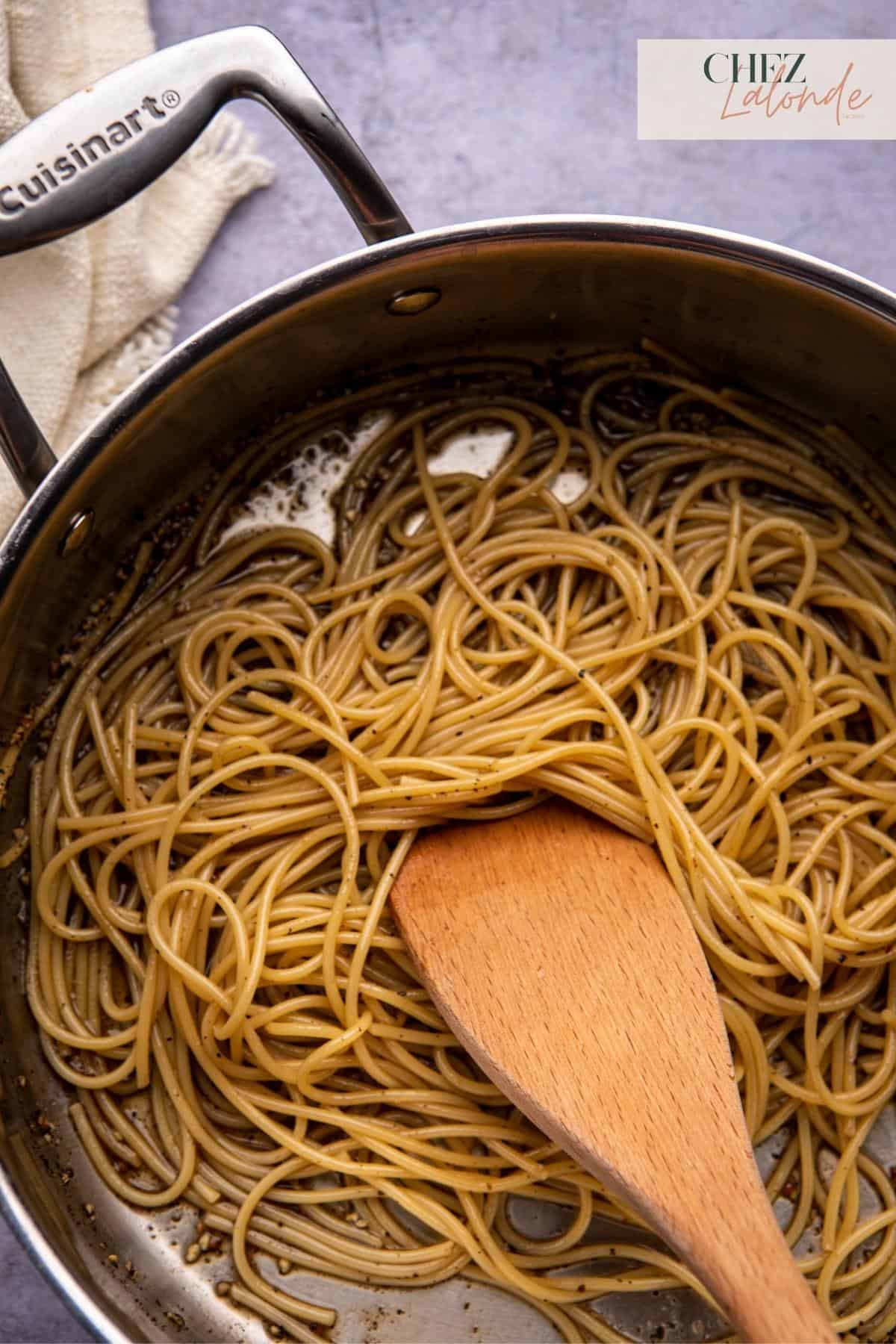
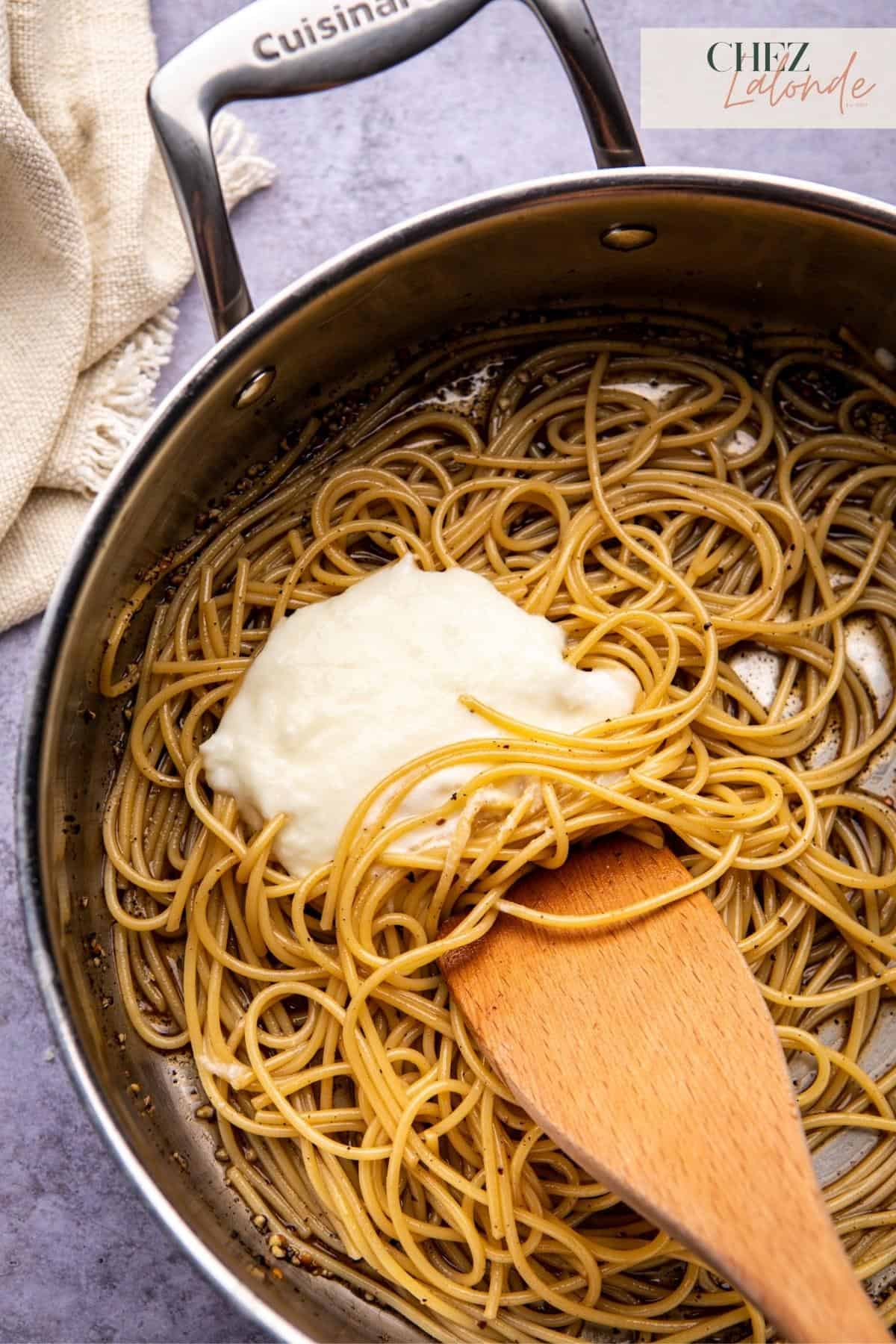
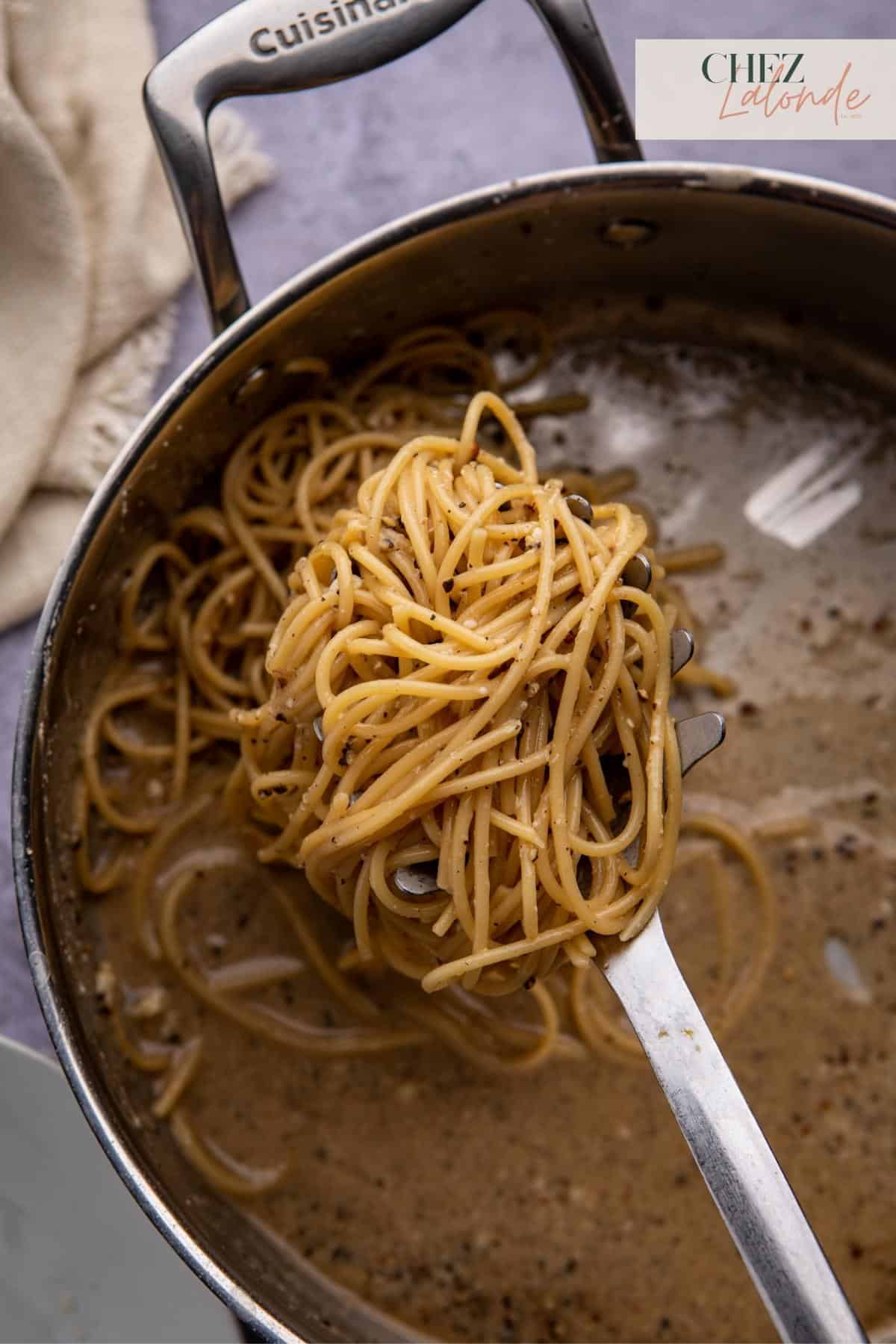
Step 6 – The dish is complete. Finish by grating additional Pecorino Romano and garnish with black pepper. Then enjoy!
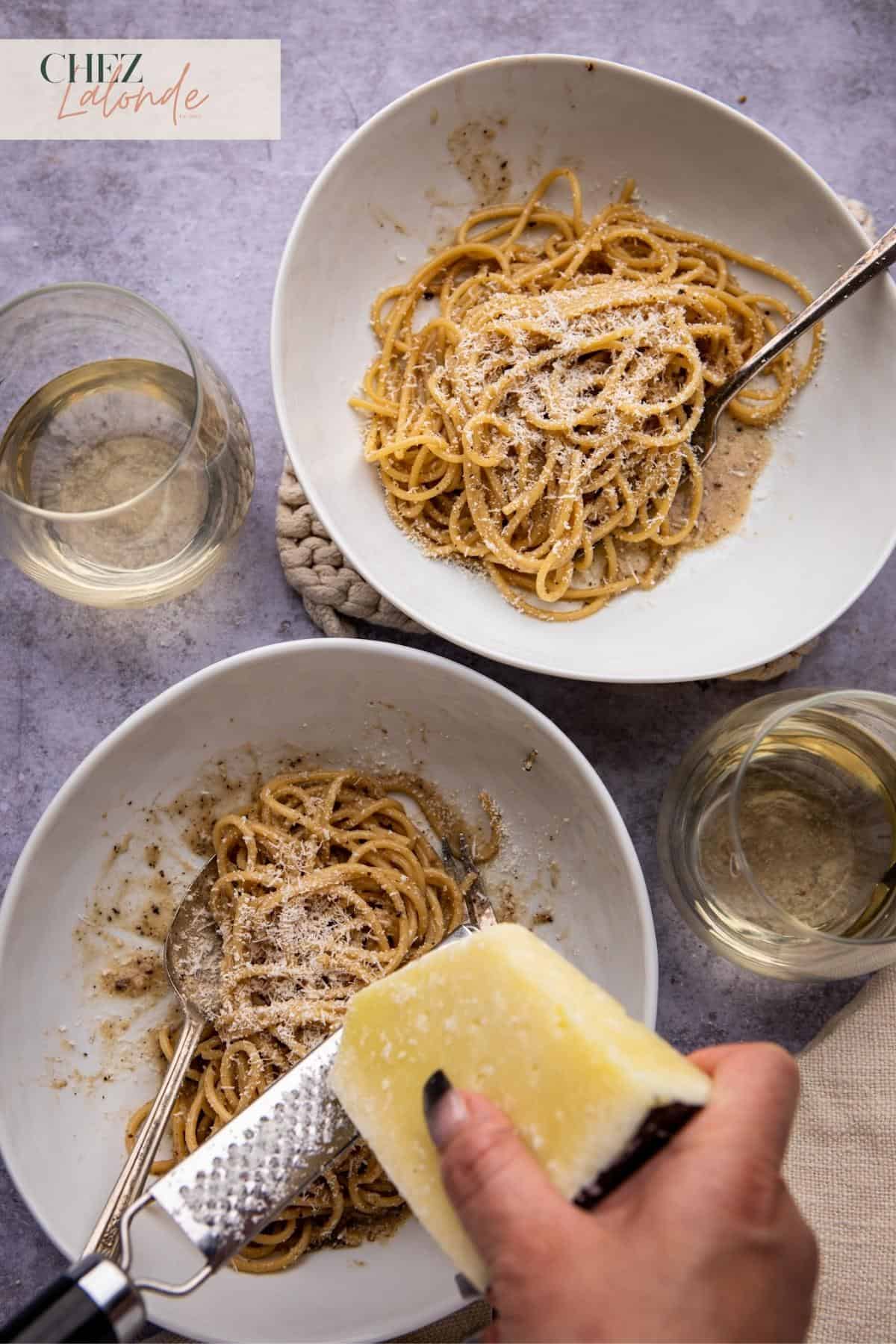
Why is Cacio e pepe so hard to execute perfectly?
Cacio e Pepe seems like a simple dish, but surprisingly only a few can master it. There are three main issues that home chefs face when attempting to make this classic Italian pasta dish.
1) Cheese doesn’t melt and clumps together:
Finer cheese is the key to a creamy, smooth sauce when making pecorino romano. You need to use a Microplane tool to create an ultra-fine consistency – otherwise, the cheese won’t melt correctly and will leave you with a gooey mess. Ensure your cheese is finely grated for that perfect, silky sauce!
2) Pasta water and cheese are not forming the right paste-like consistency:
To ensure that the combination of grated pecorino romano cheese and pasta water is perfect, it’s essential to pay attention to the temperature of the water. If it’s too hot, the protein and fat in the cheese will separate and create an oily, clumpy mess. On the other hand, if it has cooled down too much, it won’t be hot enough to properly melt the cheese, leaving you with a combination of cheese-water. The solution is simple – use a cooking thermometer to heat your pasta water to 140 F/ 60 C – this is the ideal temperature for perfectly melting your cheese into your pasta water. Also, using the right cheese and water ratio is important too. Always remember it is 2 part cheese to 1 part pasta water.
3) Pepper tastes bitter and burned:
To ensure your black peppercorn is not overly toasted, toast it over a low heat setting for no more than 45 seconds. Once you can smell its fragrant aroma, your toasting is complete – if you overdo it, your peppercorn will ruin the dish and make it taste unpleasant.

How to store and reheat your pasta:
Cacio e pepe pasta is best enjoyed on the same day. However, if you need to reheat leftovers, consider using the “Sous Vide” method for the best results.
If you want to reheat your Cacio e pepe pasta in the best way possible, consider using sous vide. Here’s how:
- Place your cooked pasta in a Ziploc or vacuum-sealed bag.
- Fill a pot with water and set your Sous Vide machine to 130F/54C.
- Once the water reaches the desired temperature, submerge the bag and let it sous vide for 20 minutes.
- When the pasta is warmed up, it’s ready to eat!
You can use Sous Vide to ensure your Cacio e pepe pasta is heated evenly without losing its flavor or texture. Please note that this pasta should not be frozen or reheated in the microwave. The dish contains cheese sauce, which can compromise the dish’s quality.
If you’re unfamiliar with the Sous Vide technique, you can learn more about this useful French culinary technique by visiting my blog post on “Sous Vide Filet Mignon.”
For even more Pasta recipes, you may like these:

FAQs about Cacio e Pepe:
In Conclusion,
There’s no denying it, Cacio e Pepe is a classic Italian dish that everyone should try at least once. Its simple combination of pasta, cheese, and black pepper makes it the perfect way to end an Italian feast. While it may be simple to make, its sophisticated flavor and unforgettable texture create a memorable taste that will stay with you forever. So don’t hesitate to try this timeless Italian classic pasta tonight!
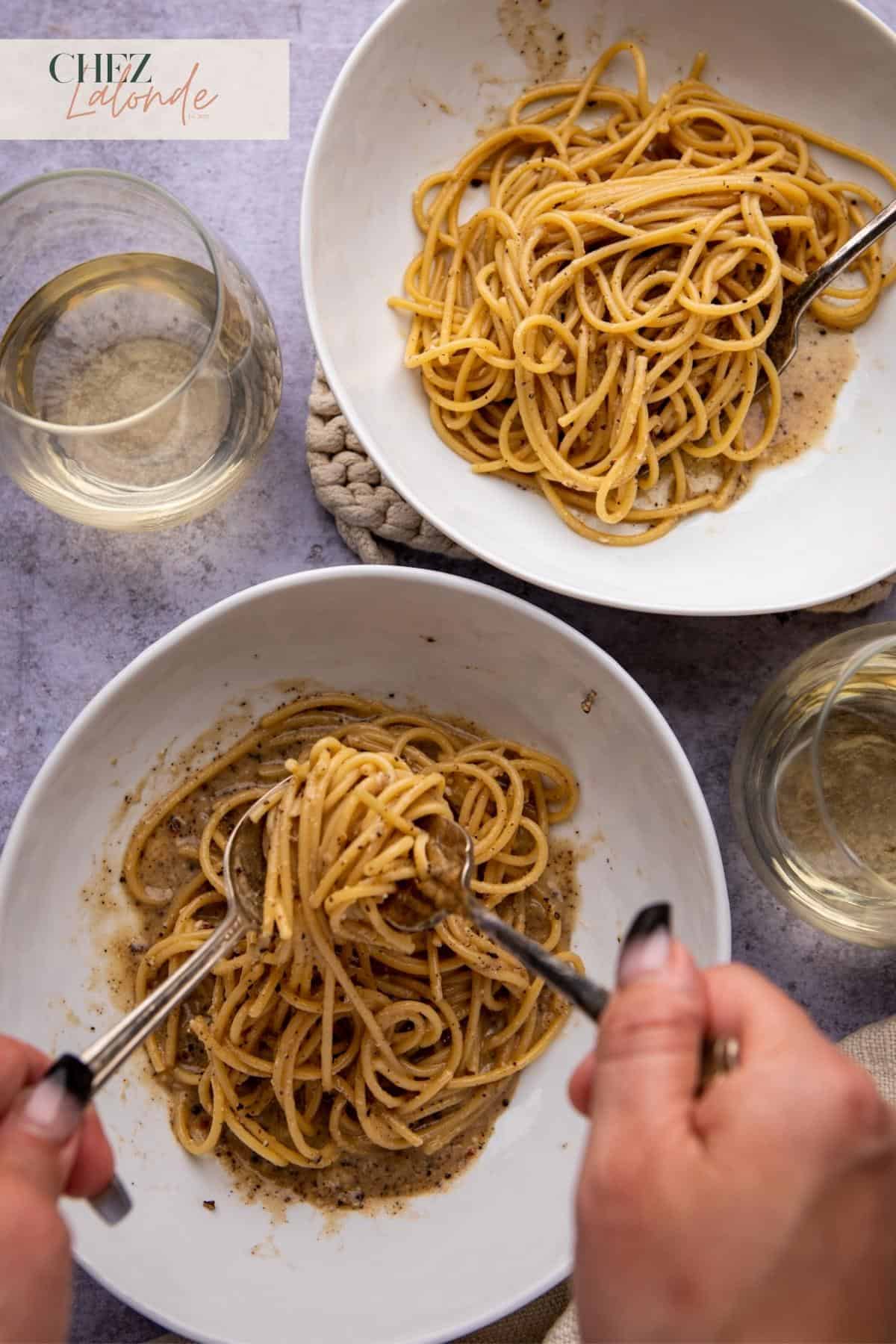
Ready to give this classic Italian dish a try? Follow my blog and social media for more delicious recipes like Cacio e Pepe, and share your photos with us when you make this dish at home.
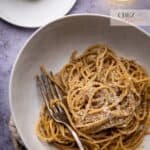
The Best Authentic Italian Cacio e pepe Pasta Recipe
- Total Time: 30 minutes
- Yield: 2 portions 1x
Description
Experience the tantalizing taste of authentic Italian cooking with Cacio e pepe! This classic pasta dish combines creamy pecorino cheese, freshly cracked pepper, and al dente paste for a memorable meal. With its simple yet delectable flavor profile, this timeless recipe will surely please even the pickiest of eaters. Enjoy the traditional flavors of Italy with this hearty and satisfying dish!
Ingredients
160 grams of Spaghetti (or Pasta of your choice)
80g Finely grated Pecorino Romano cheese
1/2 Tablespoons of Toasted whole black peppercorns
1 1/2 Cups of Pasta Water
Instructions
Toast the black peppercorns:
Step 1 – Heat a small frying pan on low heat and add two tablespoons of whole black peppercorns. Toast the peppercorns for 30 to 45 seconds or until fragrant. You then crush the peppercorns in a mortar and pestle or put them in a ziplock bag, and use a meat tenderizer or rolling pin to crush them. Set your crushed pepper aside.
Cooking the pasta:
Step 2 – To get an irresistibly creamy and starchy cheese sauce, start here. First, fill a large pot with less water than usual. Add ¼ cup of sea salt to the water and bring it to a boil. Cook the pasta until it’s halfway done, following the package instructions – for example, if it says 10 minutes, cook for 5-6 minutes. Then finish cooking the pasta in the next step until it reaches al dente perfection.
Prepare the pepper water:
Step 3 – Heat a large frying pan over medium heat. Add the toasted crushed black pepper and one and a half cups of starchy pasta water. Bring the mixture to a boil, then add the pasta. Cook until the pasta is al dente.
Prepare the creamy cheese sauce:
Step 4 – Take a clean bowl and use a Microplane to grate the pecorino romano cheese blocks finely. Measure approximately 40 to 50 grams of grated cheese per person using a cooking scale. Add starchy cooking water to the cheese and mix until it forms a paste-like consistency.
Assemble the dish:
Step 5 – Remove the cooked pasta from the stove; slowly add the cheese mixture to the cooked pasta, one bit at a time. Mix the ingredients together quickly and evenly so that all the pasta is completely coated. To avoid clumping and an off texture, avoid adding the cheese sauce to hot pasta at once.
Step 6 – The dish is complete. Finish by grating additional Pecorino Romano and garnish with black pepper. Then enjoy!
Notes
Maintaining a 2:1 ratio of cheese to the cooking water when combining the cheese and pasta water. For example, if you make the dish for two people, you will need 80 grams of grated Pecorino Romano cheese and 40 grams of the starchy cooking water.
- Prep Time: 15 minutes
- Cook Time: 15 minutes
- Category: Entree
- Method: Stove top
- Cuisine: Italian
Keywords: pasta, Pecorino Romano, creamy sauce, Italian food, Roman pasta, authentic, black peppercorn.


